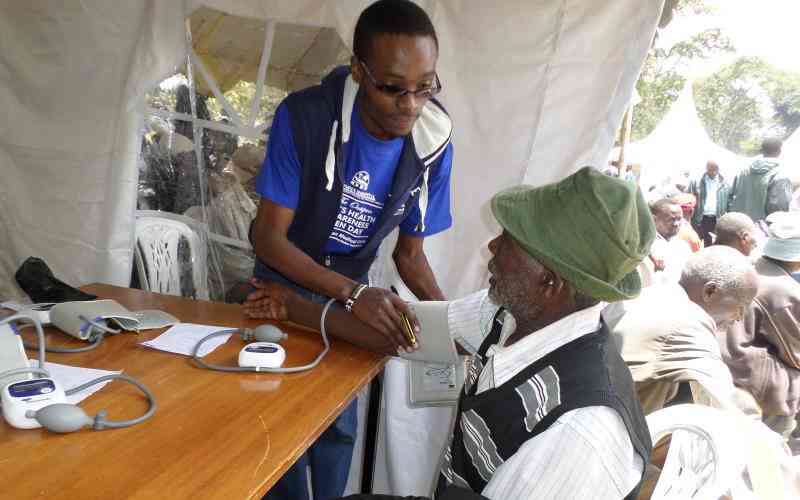
Sciatica is an ailment characterised by low back pain radiating downwards into the left or right buttock and on to the leg via the Sciatic nerve. Early signs include numbness and burning feet despite the pain.
With Sciatica, your bottom, back of your leg, foot, and toes will feel weak, numb, painful, and tingling.
Peter Maina, 36, works in the hospitality industry. He once tried lifting a load but couldn’t, and when he tried bending he says, “I could feel a sharp pain from the left side of my neck. Then it moved to my backside and the lower shoulder.” Maina was given a Deep Heat spray to calm his pain but it persisted.
By the following morning, turning his neck was near impossible. A doctor said the pain was not normal and referred him to a physiotherapist. “At that time I had a lot of back pain, shoulder pain and my neck was stiff. I was walking with a lot of strain.”
The physiotherapist diagnosed muscle and nerve problems that might have been triggered by lifting heavy loads. The specialists also said the cause was not specific as it could have been from “sitting for long, sleeping in a bad posture, watching a screen for long in an uncomfortable position or twisting a muscle while exercising.”
After thorough massage in pained areas, his stiff neck started to relax. The therapy included taking nerve medication and painkillers during the recommended 10 sessions of physiotherapy.

“My shoulders are now good, I can move my neck from one end to the other,” says Maina, adding that physiotherapy is different from normal massage.
Sarah Konzie, a certified physiotherapist at Silver Physiotherapy, says physiotherapy is part of clinical medicine that helps to restore normal life after an injury that affects the muscles, joints, nerves, tendons or spine.
About 70 per cent of physiotherapy uses hands while 30 per cent uses machines known as electrical physical agents. In her line of work, Konzie says she deals with “stiff joints, stiff muscles caused by a condition like arthritis, nerve problems, stroke rehabilitation, vertigo, and sports problems.”
The hallmark of sciatica is pain that radiates from the lower (lumbar) spine to the buttock and down the back of your leg with discomfort almost anywhere along the nerve pathway.
The pain can vary; from a mild ache to a sharp, burning sensation or excruciating pain. Sometimes it can feel like a jolt or electric shock. It can be worse when you cough or sneeze, and prolonged sitting can aggravate symptoms. Usually, only one side of your body is affected.
The nerve has the motor and sensory functions, when the sensory nerve is affected one feels a cold or burning sensation on the leg.
Konzie recalls one patient who wore five pairs of socks because the legs were cold. “When I assessed her she had sciatica which had not yet affected her motor.”
The major cause of back pain with the sciatica nerve is usually the disc which is jelly-like and makes the spine flexible.
Once the disc is under pressure, it can bulge or prolapse.
Once it gets into the nerve space it irritates the sciatica nerve, sending pain to the legs.
Sciatica can be triggered by falling in the bathroom and landing on the buttocks. The pressure on the low backbone may cause it to move from its space which can irritate the nerve.
Other causes include aging, arthritis and spondylosis. The main challenge in treating sciatica is that patients come in when the pain is too severe.
“Some assume it runs in the family if their grandmother or aunt had back pain and so they take pain killers and only seek help after suffering for long,” Konzie says.
Rehabilitating sciatica nerve pain takes about six weeks when the case is not too severe.
Sciatica mostly affects women because of issues like giving birth which affects the spine.
Other reasons include sitting for long, lifting loads the wrong way, and sleeping in the wrong posture.
Konzie said back pain with sciatica can affect anyone despite their age.
 The Standard Group Plc is a multi-media organization with investments in media platforms spanning newspaper print
operations, television, radio broadcasting, digital and online services. The Standard Group is recognized as a
leading multi-media house in Kenya with a key influence in matters of national and international interest.
The Standard Group Plc is a multi-media organization with investments in media platforms spanning newspaper print
operations, television, radio broadcasting, digital and online services. The Standard Group is recognized as a
leading multi-media house in Kenya with a key influence in matters of national and international interest.











